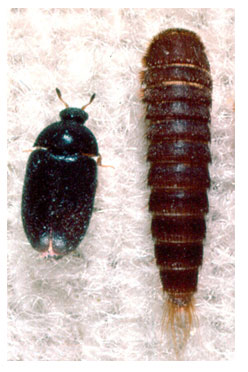Black Carpet Beetle
 The Black Carpet beetle is the most common and most destructive of the five important species of carpet beetles in the United States. It damages household products containing keratin, a principal protein found in animal hair and feathers. Plant products such as cereals and grains, as well as synthetic fabrics not derived from animal matter, may also be attacked. Dried insect specimens, such as those found in insect collections, are also devoured.
The Black Carpet beetle is the most common and most destructive of the five important species of carpet beetles in the United States. It damages household products containing keratin, a principal protein found in animal hair and feathers. Plant products such as cereals and grains, as well as synthetic fabrics not derived from animal matter, may also be attacked. Dried insect specimens, such as those found in insect collections, are also devoured.
The black carpet beetle is found throughout the United States, Canada, and Mexico. It is believed that this pest may have been imported to the United States in the early 19th century from Europe where it is not considered a major pest. Humidity plays a large role for development of carpet beetles. In the southern states, high humidity may often cause the black carpet beetle's eggs to become moldy while in the northern states lower humidity is usually favorable for a successful egg hatch..
The adults are shiny, black, oval beetles that are 1/8– to 3/16-inch long with brown legs. The larvae are red-brown and carrot shaped. They are densely covered with short stiff hairs and have a tuft of long hairs at the tip of the abdomen. The black carpet beetle undergoes complete metamorphosis, passing through the egg, larva, pupa, and adult stages. This cycle requires two months to two years depending on temperature.
Black Carpet Beetle control begins with a thorough inspection to locate the source or sources of the infestation. These insects can be found in a great variety of locations due to their wide food range. The key to successful control begins with good sanitation.
 The Black Carpet beetle is the most common and most destructive of the five important species of carpet beetles in the United States. It damages household products containing keratin, a principal protein found in animal hair and feathers. Plant products such as cereals and grains, as well as synthetic fabrics not derived from animal matter, may also be attacked. Dried insect specimens, such as those found in insect collections, are also devoured.
The Black Carpet beetle is the most common and most destructive of the five important species of carpet beetles in the United States. It damages household products containing keratin, a principal protein found in animal hair and feathers. Plant products such as cereals and grains, as well as synthetic fabrics not derived from animal matter, may also be attacked. Dried insect specimens, such as those found in insect collections, are also devoured.